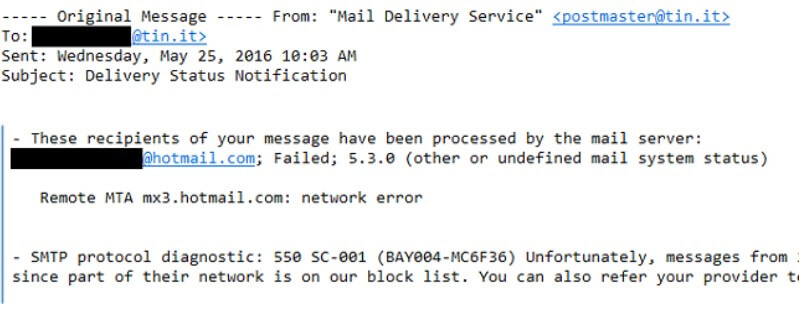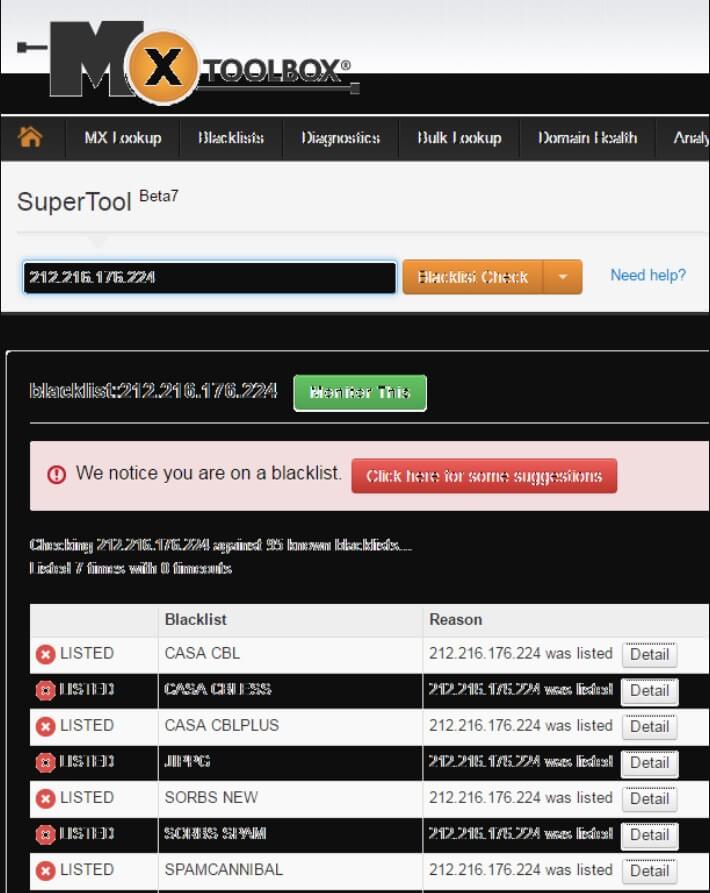Any email account you use can happen, sometimes quite often, to receive the Delivery Status Notification message: the email comes back and is not delivered to the recipient.
Other times it happens to receive an Undelivered Mail Returned to Sender email containing, in the form of an attachment, an email message that has never been sent (often written in another language). Many doubt that their email account has been hacked and used to send messages by third parties (spam, malware, phishing, …).
What is the reason for these abnormal behaviors?
Let’s say immediately that the reason for the failure to deliver the email is indicated in the mail Delivery Status Notification.
Why emails are not delivered to the recipient
In the vast majority of cases, the Delivery Status Notification message’s receipt is due to the SMTP server (outgoing mail server) you are using.
The public IP addresses of many SMTP servers managed by very famous Italian providers are often included in blacklists. This happens when, from the same IP, some providers begin to detect the sending of large quantities of spam emails, linked to spammers’ activity or the spread of malware campaigns.
It may therefore happen that some of the SMTP server addresses used by customers of the same provider are included in the “blacklists” used internationally, and users receive the Delivery Status Notification message.
A concrete example: in the image theDelivery Status Notification error received from a user who has set up the mail.tin.it SMTP server and sent a message to a Hotmail account

The email is not delivered to the recipient on Hotmail, and the sender receives the Delivery Status Notification error.
By opening the error message (usually the Mail Daemon sender as the sender followed by the recipient’s provider), you can investigate the reasons for the message failure. The reported error explains exactly the reason for the non-delivery.
In the example in the figure, the recipient’s mail server replies that the email cannot be delivered because its IP address is in the block list.
By typing the.

Some servers also provide suggestions for solving the problem and getting mail delivered correctly. For example, Hotmail uses “ad hoc” error codes to pinpoint any problem that prevented regular email delivery (see this page ).
When you receive the Undelivered Mail Returned to Sender error for emails you have never sent.
Using someone else’s address as the sender of the email is the simplest thing to do (the practice of email spoofing ).
Those who send spam emails try to spread malware or start phishing campaigns to indicate real email addresses as sender. What makes the difference is that the email will not originate from the mail servers that manage that account.
Unfortunately, even today, some companies induce users to believe that a message is authentic simply because of the sender indicated.
In reality, the fact that a message appears to appear to come from a certain email address does not guarantee anything.
Therefore, if an attacker indicates your email address as the sender but uses his SMTP to send it, in all likelihood the email prepared by him will run into the checks exercised by the recipient’s mail server.
You will often receive Delivery Status Notification errors for user unknown (recipient account unknown or non-existent) to your email address or, even more often, spam message rejected (means that the message was recognized as junk).
For greater scruple, you can establish the mail server’s IP address from which the email started. This will allow you to remove any doubts about the violation of your email account.
As explained in the article, it is good to remember that the information sought can be extracted by analyzing the email headers (Delivery Status Notification messages, which usually appears as an attachment with the name Undelivered message ).
The last indication Received: fromfrom top to bottom, it will suggest the source system’s IP address from which the email was sent.
By copying and pasting the message headers in the How To Perform An Email Header Trace box on this page and clicking on Verify, you can instantly know the system from which the email was sent.
How to avoid receiving Delivery Status Notification errors and obtain correct email delivery
We provide some tips to get emails delivered correctly and avoid receiving Delivery Status Notification errors :
1) First, try to use another SMTP server of the same provider by replacing it in the mail client settings.
2) Use SSL / TLS to send email via SMTP server and make sure your provider provides authentication with username and password (see Email: SSL, TLS, and STARTTLS. Differences and why to use them )
Take this opportunity to enable the use of SSL / TLS protocols also for incoming mail.
Instructions for activating authentication and encryption on your account are usually contained on the provider’s support page.
Switching to the use of SSL / TLS protocols is often decisive because the SMTP servers are used for the black list, or this happens much less frequently.
3) Check that your public IP address is not blacklisted .
To proceed, just check – first of all – your public IP by accessing, for example, one of the following websites:
– DNSStuff
– IPify
– Icanhazip
This IP will then always be pasted on the page mentioned above .
If you are using a business connection, we suggest you try to ask your Internet access provider for a static IP from the provider and make sure that this IP is not blacklisted :
4) At least with large providers, it can often happen that one or more SMTP servers are blacklisted.
The “last” solution could be to evaluate the migration to another account by activating the forwarding of messages from the old to the new address or to evaluate a sort of “import” of the old account into the new one.

A tech-savvy writer with a knack for finding the latest technology in the market, this is what describes John Carter. With more than 8 years of experience as a journalist, John graduated as an engineer and ventured soon into the world of online journalism. His interest includes gadget reviews, decoding OS errors, hunting information on the latest technology, and so on.













